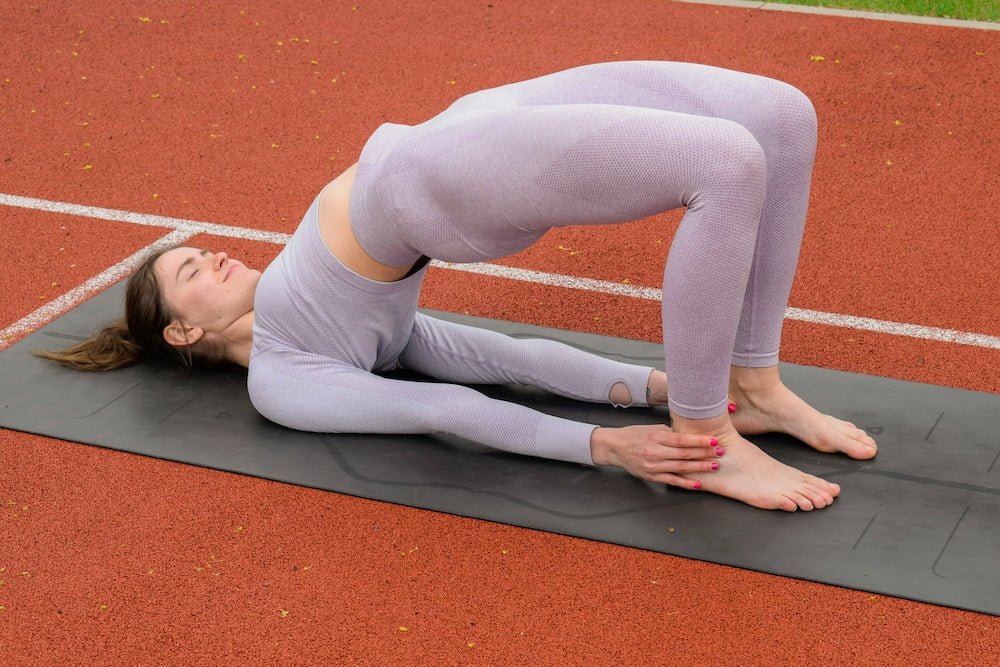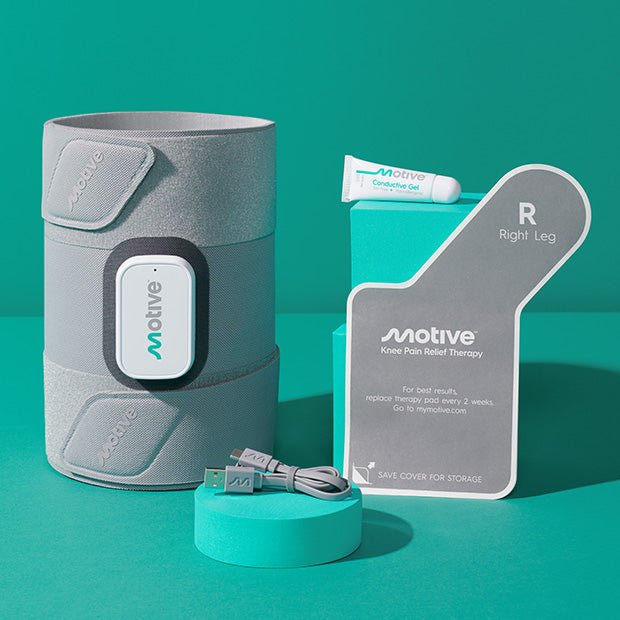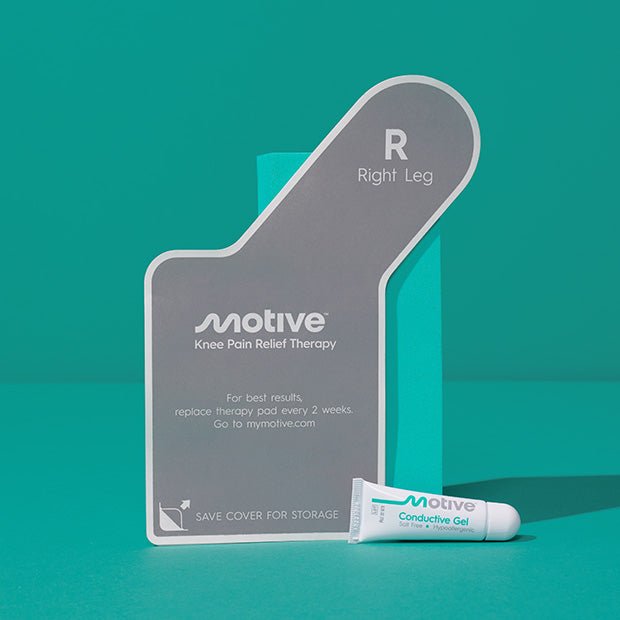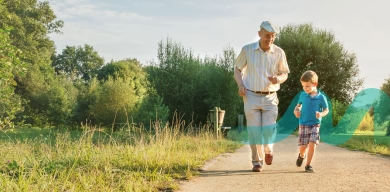
Knee stiffness and pain are prevalent issues, often stemming from osteoarthritis, rheumatoid arthritis, and knee injuries. A study by the CDC shows that about 15% of adults suffer from joint pain due to common types of arthritis. Additionally, sports injuries and age-related wear and tear also contribute significantly to knee problems.
In this article, we’ll review some of the common causes of knee pain and stiffness, preventative measures, and steps to take to alleviate it at the core.
Understanding Knee Pain and Stiffness
Knee pain can arise from problems in the knee joint itself or from conditions affecting the ligaments, meniscus, and bones (femur, tibia, and patella) within the joint. The knee joint, being one of the most complex in the human body, is susceptible to a variety of injuries and conditions.
Osteoarthritis, a common type of arthritis in the knee, occurs when the shock-absorbing cartilage wears down, leading to pain and stiffness. Rheumatoid arthritis, another type, is an autoimmune condition that causes inflammation in the joint. Sprains and strains, often resulting from physical activities, can also cause acute pain and discomfort.
Understanding the specific cause of knee pain is essential for choosing the right treatment approach.
Early Arthritis: Identification and Management
Early signs of knee arthritis include swelling, stiffness, and a gradual increase in pain. Recognizing these signs early can lead to more effective management and slower progression of the condition.
In addition to using over-the-counter nonsteroidal anti-inflammatory drugs like ibuprofen, incorporating natural anti-inflammatory agents like turmeric and ginger into the diet can also be beneficial. Regular, gentle exercise helps maintain joint mobility and reduce stiffness.
An X-ray or MRI scan can be instrumental in diagnosing osteoarthritis of the knee and assessing the extent of joint damage.
Athletic Knees: Prevention and Care
Athletes, particularly those involved in high-impact sports, are at risk of knee injuries like ACL tears, meniscal tears, and tendonitis. Preventative strategies include proper training techniques, wearing appropriate sports gear, and incorporating exercises that strengthen the knee ligaments and tendons.
It's important for athletes to listen to their bodies and avoid overtraining, as persistent overuse can lead to chronic knee problems. Regular stretching, especially post-exercise, can help maintain flexibility and reduce the risk of injuries.
To further enhance knee injury prevention and care among athletes, additional measures can be taken to ensure knee health is prioritized in sports activities. These measures not only help in preventing knee injuries but also aid in the care and recovery process if an injury occurs:
Warm-Up Properly: Before engaging in any physical activity, a comprehensive warm-up that includes dynamic stretching is essential. This increases blood flow to the muscles, improves flexibility, and prepares the knees for a full range of motion in sports activities.
Focus on Technique: Proper technique in all sports activities cannot be overstated. Incorrect form, especially during high-impact moves or weightlifting, can place unnecessary strain on the knee joint. Athletes should work with coaches or trainers to ensure their form is correct to minimize the risk of injury.
Strengthening Exercises: Specifically target the muscles around the knees—the quadriceps, hamstrings, and calves—as well as the core muscles. Strong muscles provide better support for the knee joint and can absorb the shock and stress that come from high-impact activities.
Use of Proper Footwear: Wearing the right shoes for the specific sport can make a significant difference in preventing knee injuries. Shoes that provide adequate support and fit well can reduce the impact on the knees during exercise.
Adequate Rest and Recovery: Rest days are crucial in any training program. They allow the body, including the knee joints, to recover and heal from the stresses of physical activity. Ignoring rest days can lead to overuse injuries.
Hydration and Nutrition: Proper hydration and a balanced diet support overall health and aid in the prevention of injuries. Nutrients like calcium and vitamin D are essential for bone health, while omega-3 fatty acids can help reduce inflammation in the joints.
Immediate Attention to Pain: Athletes should never ignore knee pain. Early intervention is key to preventing more serious injuries. If knee pain occurs, reducing activity levels and seeking evaluation from a healthcare provider or sports medicine specialist is important.
Regular Medical Check-Ups: Routine evaluations by a healthcare professional can help detect potential issues before they become serious. This is especially important for athletes who have previously experienced knee injuries.
Incorporating these practices into training routines and daily life can significantly reduce the risk of knee injuries for athletes and assist in the care and recovery process should an injury occur. Being proactive about knee health is crucial for long-term athletic performance and overall well-being.
Daily Routines to Combat Knee Stiffness
Consider integrating the following practices into your lifestyle for combating knee stiffness to maintain knee health and flexibility:
Morning Stretch Routine
Start your day with a series of gentle stretches to wake up the muscles around your knees. Include calf stretches, hamstring stretches, and quadriceps stretches. Holding each stretch for at least 30 seconds can help reduce stiffness throughout the day.
Chair Exercises
For those who spend a lot of time sitting, performing seated leg lifts and ankle rotations can keep blood flowing to the knee joints and strengthen the muscles that support them. Try doing sets of 10-15 repetitions, focusing on slow, controlled movements.
Standing Desk Breaks
If you use a standing desk, take regular breaks to perform mini-squats or knee bends. This can prevent stiffness from standing in one position for too long and strengthen the knee area.
Midday Walks
Incorporate short, brisk walks into your lunch break. Walking is a low-impact activity that helps keep the knee joints lubricated and strengthens the muscles supporting them without placing too much strain on them.
Evening Foam Rolling
Using a foam roller on the thigh and calf muscles in the evening can help alleviate tension and tightness that accumulates throughout the day. This practice can also improve circulation around the knees, promoting healing and flexibility.
Balance Exercises
Incorporate balance exercises such as standing on one leg or using a balance board. These exercises strengthen the muscles around the knees and improve proprioception, which can help prevent injuries and reduce stiffness.
Tai Chi or Qigong
These gentle martial arts practices are excellent for improving flexibility, balance, and strength, with a focus on slow, flowing movements that are perfect for individuals with knee stiffness.
By incorporating these routines into your daily schedule, you can help manage and reduce knee stiffness, improve mobility, and support overall knee health. Remember to listen to your body and adjust the intensity of the exercises according to your comfort level to avoid overexertion and potential injury.
Managing Pain at Home: Safe and Effective Strategies
To effectively manage knee pain at home, consider incorporating a holistic approach that includes various methods to alleviate discomfort and enhance knee function. Beyond the initial steps of using ice packs, heat therapy, elevation, and compression, there are several strategies you can adopt:
Anti-inflammatory Diet
Incorporating foods that are known for their anti-inflammatory properties can help reduce knee pain. Foods rich in omega-3 fatty acids, such as salmon, flaxseeds, and walnuts, along with fruits and vegetables high in antioxidants, can support joint health and reduce inflammation.
Supplementation
Glucosamine and chondroitin supplements are often recommended for knee pain as they may help rebuild cartilage and lubricate the knee joint. Always consult with a healthcare provider before starting any new supplement regimen.
Hydrotherapy
Warm water exercises in a pool can be exceptionally beneficial for knee pain. The buoyancy of water takes the pressure off the knee joints, while the resistance helps strengthen the surrounding muscles without adding strain.
Weight Management
If you're carrying extra weight, losing even a small percentage can significantly reduce the stress on your knees. This can be achieved through a balanced diet and regular exercise, tailored to your physical abilities and goals.
Regular Exercise and Strengthening
Focusing on exercises that strengthen the muscles supporting your knees, such as the quadriceps, hamstrings, and calf muscles, can help alleviate pain and improve knee function. Low-impact exercises like cycling, swimming, and using an elliptical machine are excellent options.
Motive: Motive offers a targeted solution designed to strengthen the quadriceps muscles, which are crucial for knee support and stability. The Motive Knee combines personalized physical therapy exercises with the convenience of home practice, making it an effective option for individuals with knee arthritis, stiffness, and other knee-related issues.
By adopting a combination of these strategies and considering innovative solutions like Motive, you can manage knee pain effectively at home, improving your quality of life and mobility.
When to Seek Professional Help
If knee pain persists despite home treatments, or if symptoms worsen, seeking advice from a healthcare provider is crucial. They can provide a comprehensive evaluation and recommend advanced treatment options like corticosteroid injections, hyaluronic acid injections, or ortho-biologic treatments.
In cases where conservative treatments are ineffective, surgical options like arthroscopy, partial knee replacement, or total knee replacement may be considered.
Manage Knee Stiffness and Pain with Motive
Adopting a holistic approach to managing knee stiffness and pain is key. This includes understanding the root causes, such as osteoarthritis or rheumatoid arthritis, and addressing them with a combination of physical therapy, lifestyle changes, and, when necessary, medical intervention.
Motive's focus on strengthening the quadriceps can provide significant relief and improve knee function. Motive's approach is grounded in evidence-based practices that focus on reducing knee pain and improving mobility through strength training, flexibility exercises, and balance training. By following a structured program tailored to your specific needs, you can achieve significant improvements in knee health without the need for invasive treatments.
Whether you're dealing with chronic knee pain or looking to recover from a knee injury, incorporating Motive Knee into your home care regimen can provide the guidance and support needed to navigate your recovery journey effectively. Always consult with a healthcare provider before starting any new exercise program, especially if you have pre-existing health conditions or concerns.




